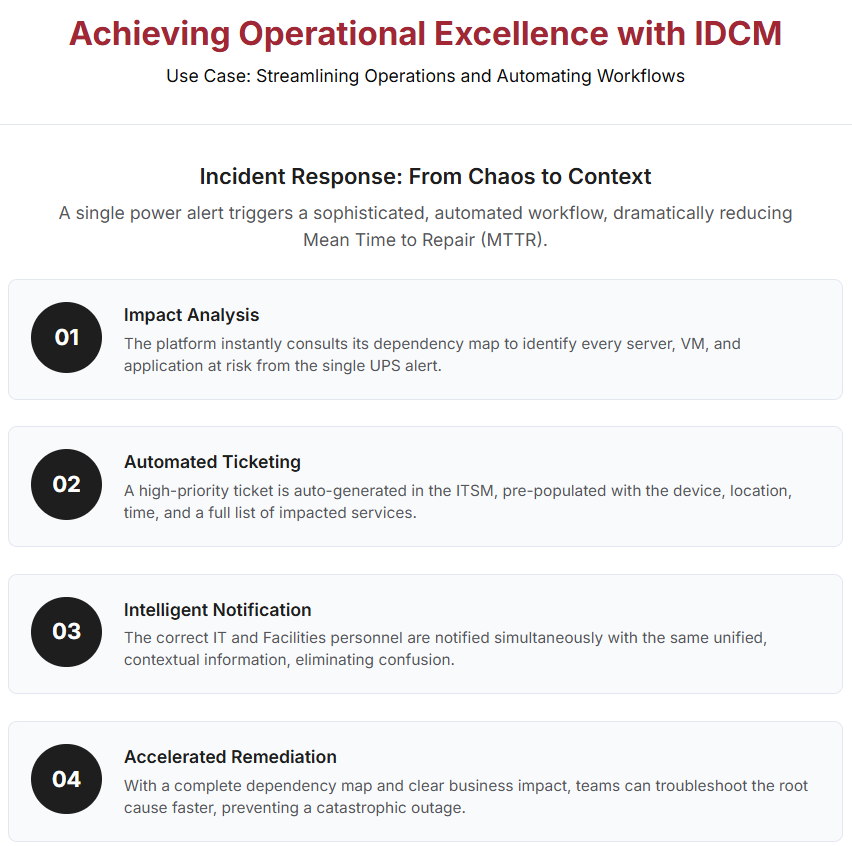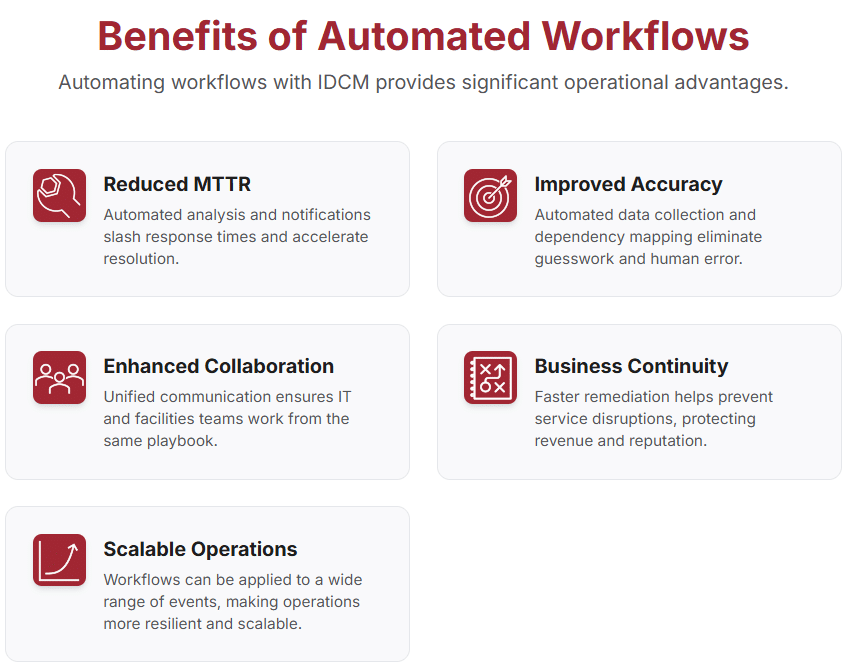IDCM Use Case: Automated Data Center Workflows
Published on August 25, 2025,
by
IDCM Use Case: Automated Data Center Workflows
In today’s high-stakes digital environment, data centers must operate with precision, speed, and resilience. Downtime is costly, and manual processes often lead to delays, errors, and inefficiencies. To meet modern demands, organizations are turning to Integrated Data Center Management (IDCM) platforms to automate operations and streamline workflows.
This blog explores a powerful use case where IDCM transforms incident response from a reactive, manual process into a proactive, automated workflow. By integrating systems across IT and facilities, IDCM enables automated data center workflows that reduce Mean Time to Repair (MTTR), minimize business impact, and improve operational agility.
The Problem with Traditional Incident Response
Imagine a critical power event in a traditional data center—say, a UPS switches to battery mode due to a utility failure. In most environments, this triggers a flurry of manual actions:
- Someone notices the alert and tries to assess its impact.
- Teams scramble to identify affected systems.
- IT and facilities personnel are contacted separately.
- Incident tickets are manually created and updated.
- Troubleshooting begins, often without full context.
This process is slow, error-prone, and stressful. Valuable time is lost, and the risk of service disruption increases.
IDCM changes the game by enabling automated data center workflows that respond intelligently and instantly to such events.
How IDCM Automates Incident Response
Let’s walk through a real-world use case to see how IDCM handles a critical power alert with speed and precision.
Event Detection
A UPS device sends an alert indicating it has switched to battery power. This alert is detected via SNMP or MODBUS, protocols commonly used to monitor power infrastructure.

Step 1: Impact Analysis
The IDCM platform immediately consults its dependency map to identify:
- All physical servers, switches, and storage arrays connected to the affected UPS
- All virtual machines running on those servers
- All business applications dependent on those VMs
This automated analysis provides a complete picture of the potential impact—within seconds.
Step 2: Automated Ticketing
The system generates a high-priority incident ticket in the integrated IT Service Management (ITSM) platform (e.g., ServiceNow). The ticket is pre-populated with:
- Device details
- Event timestamp
- Location
- A full list of impacted assets and services
This eliminates manual data entry and ensures accuracy.
Step 3: Intelligent Notification
The workflow simultaneously notifies the appropriate personnel from both IT and facilities teams. Everyone receives the same contextual information, including:
- What happened
- Where it happened
- What systems are affected
- What the business impact is
This unified communication accelerates coordination and response.
Step 4: Accelerated Remediation
Armed with a complete dependency map and clear impact analysis, response teams can:
- Pinpoint the root cause
- Prioritize affected systems
- Restore service before UPS batteries are depleted
This proactive approach prevents outages and dramatically reduces MTTR.
The Power of Integration
What makes this use case so effective is the seamless integration across domains:
- Facilities data from MODBUS and SNMP
- IT asset and workload data from DCIM and virtualization platforms
- Workflow automation via ITSM systems
Each component contributes to a unified, intelligent response. Together, they enable automated data center workflows that are fast, accurate, and scalable.
Benefits of Automated Workflows in the Data Center

Let’s explore the broader benefits of automating workflows with IDCM:
✅ Reduced MTTR
By automating impact analysis, ticketing, and notifications, IDCM slashes response times and accelerates resolution.
✅ Improved Accuracy
Automated data collection and dependency mapping eliminate guesswork and reduce human error.
✅ Enhanced Collaboration
Unified communication ensures that IT and facilities teams work from the same playbook, improving coordination and outcomes.
✅ Business Continuity
Faster response and remediation help prevent service disruptions, protecting revenue and reputation.
✅ Scalable Operations
Automated workflows can be applied to a wide range of events—from power failures to cooling alerts—making operations more resilient and scalable.
Beyond Incident Response: Expanding Automation
While this use case focuses on power events, the principles apply to many other scenarios:
- Cooling system failures
- Network outages
- Environmental alerts (e.g., temperature or humidity spikes)
- Asset changes or unauthorized access
In each case, IDCM can automate detection, analysis, ticketing, and response—creating a consistent, reliable framework for managing data center operations.
This is the future of infrastructure management: automated data center workflows that adapt to changing conditions and drive continuous improvement.
Building a Smarter Data Center
As data centers evolve to support AI, edge computing, and hybrid cloud, operational complexity increases. Manual processes are no longer sufficient. Organizations need intelligent automation to stay ahead.
IDCM platforms like Nlyte’s provide the tools and integrations needed to automate workflows, streamline operations, and improve resilience. By leveraging protocols like SNMP and MODBUS, and integrating with ITSM systems, IDCM creates a unified ecosystem that responds in real time.
Whether you're managing a critical incident or optimizing daily operations, IDCM is your path to automated data center workflows that deliver speed, accuracy, and agility.
| Are you ready to revolutionize how your organization manages its digital infrastructure?
Download our free eBook, Introduction to Integrated Data Center Management, and discover how leading enterprises are transforming their operations with a unified approach to IT, Facilities, and Operations. 👉 𝙂𝙚𝙩 𝙩𝙝𝙚 𝙚𝘽𝙤𝙤𝙠 > Integrated Data Center Management eBook by Nlyte |
![Unlock the Future of Infrastructure with Integrated Data Center Management Are you ready to revolutionize how your organization manages its digital infrastructure? Download our free eBook, Introduction to Integrated Data Center Management, and discover how leading enterprises are transforming their operations with a unified approach to IT, Facilities, and Operations. In today’s fast-paced digital world, data centers are no longer confined to a single location. They span across on-premises facilities, cloud environments, and edge computing sites. This complexity demands a new management paradigm—one that breaks down silos and enables seamless collaboration across departments. That’s where Integrated Data Center Management (IDCM) comes in. What You’ll Learn in This eBook This comprehensive guide explores the core principles and technologies behind Integrated Data Center Management. You’ll gain insights into: The convergence of Data Center Infrastructure Management (DCIM), Building Management Systems (BMS), and IT Operations. How IDCM creates a single source of truth for infrastructure visibility and control. The role of AI in predictive maintenance, dynamic optimization, and anomaly detection. Strategies for extending management capabilities to edge environments while maintaining security and uptime. Communication protocols like BACnet, MQTT, SNMP, and MODBUS that enable integration across diverse systems. Whether you're a data center operator, facilities manager, or IT leader, this eBook will equip you with the knowledge to build a resilient, efficient, and future-proof infrastructure. Why Integrated Data Center Management Matters Integrated Data Center Management is more than a buzzword—it’s a strategic necessity. By unifying traditionally separate domains, IDCM empowers organizations to: Increase operational efficiency by aligning infrastructure with workload behavior. Improve resiliency through predictive analytics and automated workflows. Enhance flexibility to adapt to evolving technologies like AI and edge computing. Reduce downtime and operational risk with real-time visibility and control. The eBook showcases how Nlyte Software’s IDCM platform delivers these benefits through intelligent placement, optimization, and centralized command capabilities. It also includes real-world use cases that demonstrate the power of IDCM in action—from advanced capacity planning to holistic energy optimization. Download the eBook Today Don’t miss your chance to stay ahead of the curve. Download Introduction to Integrated Data Center Management now and start your journey toward smarter, more integrated infrastructure management. 👉 [Download Now] This eBook is your gateway to understanding how Integrated Data Center Management can transform your organization’s approach to digital infrastructure. Whether you're planning for AI workloads, managing edge deployments, or striving for sustainability, IDCM provides the tools and insights you need. Integrated Data Center Management is the key to unlocking operational excellence. Learn how to harness its power and future-proof your infrastructure today.](https://www.nlyte.com/web/wp-content/uploads/2025/08/Introduction-to-Integrated-Data-Center-Management-an-eBook-from-Nlyte-Software.png) |

